![How Often Should You Blog? [Blog Post Frequency RESEARCH]](https://marketinginsidergroup.com/wp-content/uploads/2023/09/Screenshot-2023-08-30-at-10.04.59-AM.png)
How Often Should You Blog? [Blog Post Frequency RESEARCH]
In content marketing, consistency is the key to success. Most organizations use their blog as the corner stone of that consistency. Blogs help you attract new clients every single by answering the questions your audience asks every single day.
We believe that blogging with consistency is also necessary for content marketing to work. Frequency really does matter. But, exactly how often should you blog? Well our latest research has found the answer:
Publishing 2 -4 times per week provides the best content marketing results in terms of both traffic and conversions.
This is the answer according to the data we have seen from multiple studies, as well as much of our own client work across more than a dozen client websites in mostly B2B, some B2C and e-commerce, and across companies large and small.
So let’s start by looking at the cold, hard facts – the data on blogging frequency.
Quick Takeaways:
- The more frequently you blog, the more traffic you tend to get, as a rule of thumb.
- 2-4 posts per week is a magic number — it results in the highest gains in traffic per dollar spent.
- Publishing more frequently also increases leads for B2B companies and Revenue in B2C
- Longer content is great but consistency is better so spread out your capacity to meet weekly goals
- Try blog writing services from professional writers to get timely, relevant content to your audience without having to spend your time creating content
PS – I put together these 10 tips for optimizing your content marketing. Watch Now!
The Rule of Small Changes
“Great things are done by a series of small things brought together.”
~ Vincent Van Gogh
One of the things I learned early on in my career is that small things, done consistently can add up to great impact. Think about anything you might want to achieve in your life: becoming rich, losing weight, training for a marathon. All of these things are achievable with small changes applied consistently over time:
- Want to be a millionaire? start saving $100 / week at age 25
- Want to lose weight? Cut out 200 calories every day
- Want to run a marathon? Star running for 10 mins every day and increase by just 1 minute every day for a year
Content marketing is the same. Start by publishing 1-2 great articles every single week for a year and you’ll see massive changes:
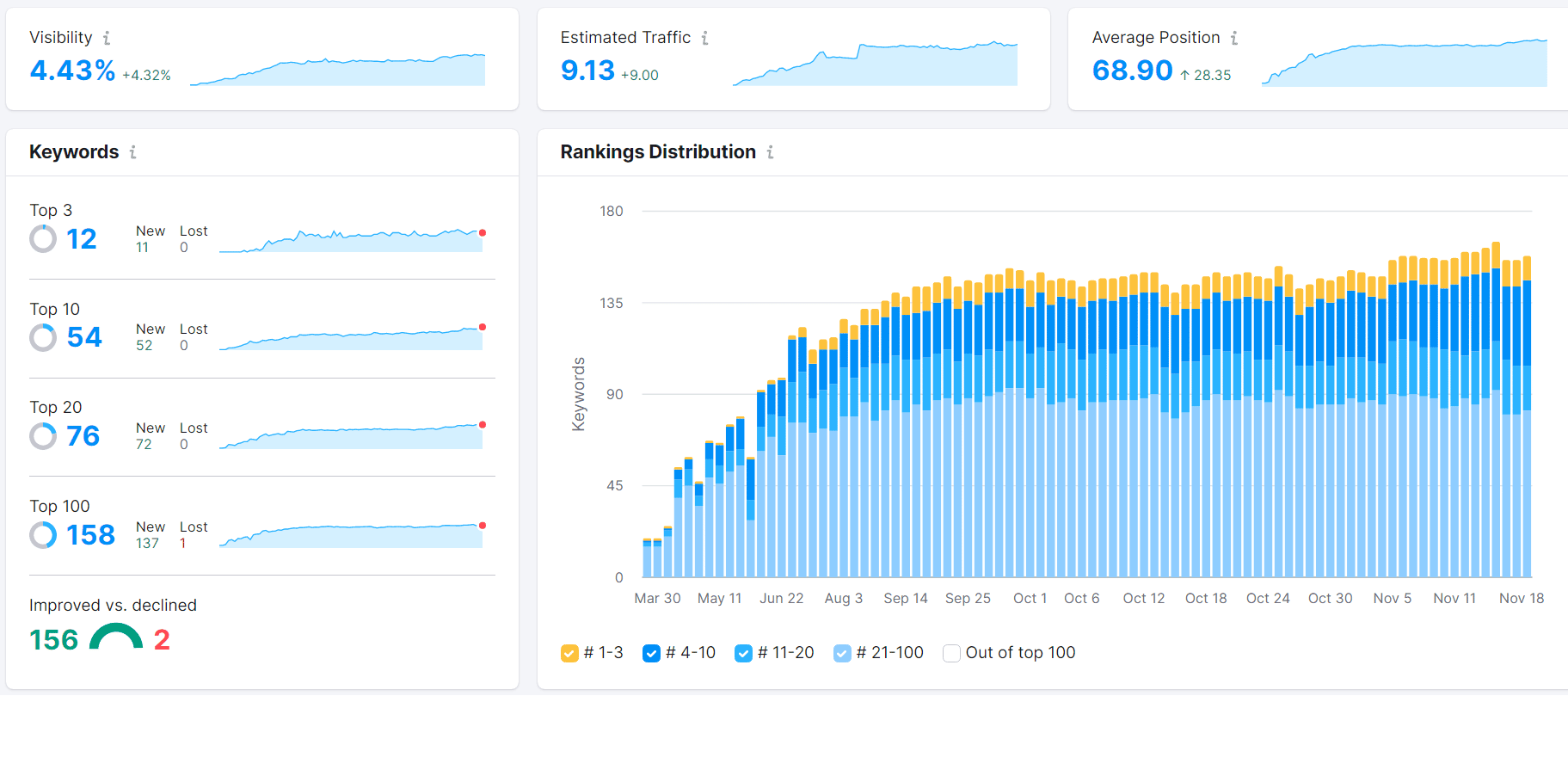
(From our most recent case study)
Start with Data
To understand how the frequency of blogging impacts its effectiveness, it’s always a good idea to start with data. HubSpot looked at blogging data from over 13,500 companies to try to answer this question. The results they provided are pretty straight forward in linking frequency and increased traffic and leads. Let’s dig a little deeper.
When you are creating your content marketing plan, a key element is how often you will publish blogs. You may think you can just pick a number randomly and that will be enough. Blogging frequency, however, is a bit more complex than that.
According to the data, companies that published 4 blog posts per week or more received 3.5 times the traffic compared to companies that blogged less than 1 times per week.
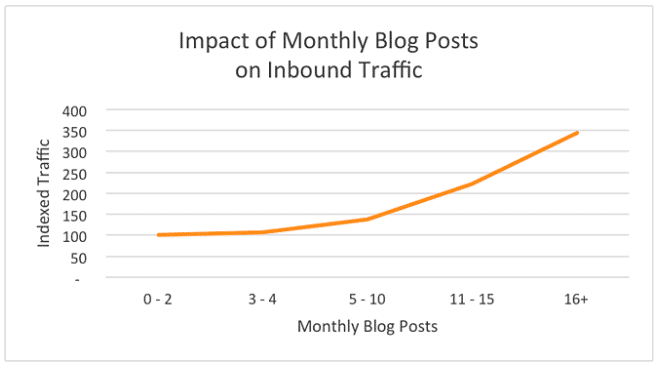
So, that’s a sound argument for being very prolific on your blog. However, there are other factors that the research looks at related to the size of the company and the differences between B2B and B2C businesses.
Does Company Size Matter?
Next, HubSpot broke down some data points based on company size.
For companies with 10 or fewer employees, they drove more traffic with around 11 blogs per month versus those that published less than 11. Those that published more than 11 blogs a month had almost three times the traffic than those publishing only one blog a month and twice as much as those that wrote two to five posts a month.
For companies that have 11 to 25 employees or over 200 employees, the magic number was again 11. When they published more than 11 posts per month, they received 3.5 times the traffic versus those that only blogged once a month.
Companies with 26 to 200 employees that publish more than 11 blogs a month had about two times the traffic compared to those that only had one blog published.
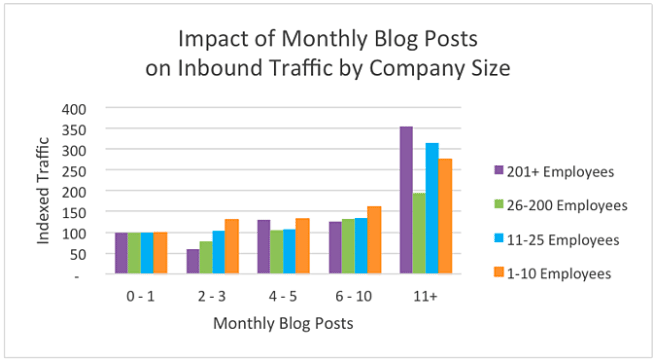
PS – Check out our weekly blog content service to grow your website traffic and leads!
B2B vs. B2C
The blogging frequency of B2B companies versus B2C companies was also reviewed. The research presented that for B2C companies, there was a consistent correlation between the number of posts and traffic to the site.
The results for B2B companies was more complicated. The data did show a positive association between frequency and traffic. When looking at companies that only blogged six to 10 times a month, they only had a slightly larger traffic pull than those that published one blog post.
The real difference was when the companies published 11 or more blogs, which drove the traffic to the site three times more than those only blogging once.
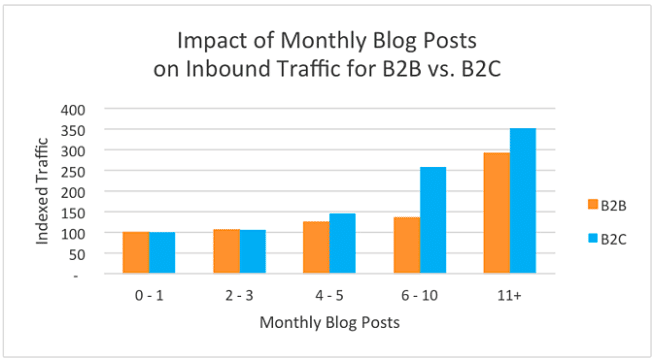
The Impact of Monthly Blog Posts on Leads
Creating great content is the attraction for leads. While the quantity of content has been shown to be associated with higher traffic, the quality of the content matters as well. Let’s look at the findings and how they affect leads.
PS – Check out our latest case study that shows how we helped one company double their leads!
Company Size, Frequency, and Lead Generation
Overall, companies that published 16 or more posts a month had 4.5 times more leads generated versus those that published four or less. Then the study breaks down the lead potential by company size:
Companies with one to 10 employees and 11 to 25 employees: The best return for these size companies on leads was publishing 10 or more blogs a month. At 11 or more, they were able to generate twice as many leads as companies publishing only six to 10 blogs.
Companies with 26 to 200 employees: Blogging at least 11 times for these companies produced about 2.5 times the leads than those publishing three or fewer blogs.
Companies with over 200 employees: The ideal number for this size company was six or more blogs monthly. For these companies, they were able to capture 1.75 times more leads than their counterparts that only wrote five or fewer blogs.
B2B vs B2C
Overall, both B2B and B2C companies attracted more leads the more blogs they posted. B2C companies posting 11 or more blogs per month received more than four times than those that distributed four to five blogs.
For B2B brands, the differences were smaller but still relevant. For those blogging 11 or more times, they received 1.75 times the leads versus those blogging six to 10 times a month and around 3.75 times more than those blogging three or fewer times a month.
Total Number of Blog Posts and Traffic: What’s the True Effect?
Next, the HubSpot report looked at the total number of blog posts of the companies and how that influenced traffic to their sites. Overall, more blogs did equal more traffic. The key amount was around 400 blogs. If a blog had more than 400 total posts, it received approximately twice as much traffic as blogs with 301 to 400 posts.
Creating 400 blog posts may seem like a difficult number to reach, but if you are publishing consistently in the 10 to 15 range, then you’d see this isn’t impossible over a few years. Blogs with over 400 posts are likely to be ones that have been around for a while. This data also offers a clear reason not to delete old blogs. Instead, you can always update them as more information becomes available.
Company Size and Total Blog Posts
The study broke down the data for the number of blog posts by company size as well.
Companies with 10 or fewer employees: These brands saw a boost of traffic around the 300 mark. When they had 300 or more posts, they were able to generate 3.5 times more traffic than those with 50 to 0 blogs.
Companies with 11 to 25 employees: This size company also received the best results at 300 or more blogs, bringing in 2.75 times more traffic than those with 150 or fewer blogs.
Companies with 26 to 200 employees: 300 was again the right number. They received 1.5 times more traffic with 300+ blogs versus those that had fewer than 150.
Companies with 200 or more employees: Larger companies also enjoyed more traffic with 300 or more blogs, garnering two times more traffic than those with less than 300 posts.
B2B vs B2C
Again, both types of businesses saw increases in site visits when they had 400+ blog posts. B2C companies had 2.5 times more traffic than those with 300 to 400 posts, while B2B companies also had 2.5 times more traffic than their counterparts that had 200 or fewer posts.
Total Number of Blog Posts Correlation to Leads
The study also looked at the correlation between number of blog posts and actual leads, not just traffic. Companies that published 400 or more posts received over three times the leads versus companies with less than 100 blogs.
There were also differences in the number of leads based on the size of the company. Companies with less than 10 employees publishing 300 or more blog posts had 3.5 times the amount of leads than those with fewer than 50 published posts.
Companies with 11 to 25 employees with 300 or more blog posts got more than two times the leads versus those with 151 to 300 posts.
For companies with 26 or more employees, they also had more leads but not as much as smaller companies. They were likely to capture 1.5 times more leads with 300 or more blog posts compared to those that published 25 or less.
In the difference between B2B and B2C companies, B2C companies had the edge, generating 4.5 times more leads when they had 400 or more posts compared to those with 100 or less total posts. B2B companies with over 400 blog posts delivered three times as many leads than those B2B brands with 200 posts or less.
I’ve summarized this data on this chart to show the correlation between frequency, traffic and conversions:
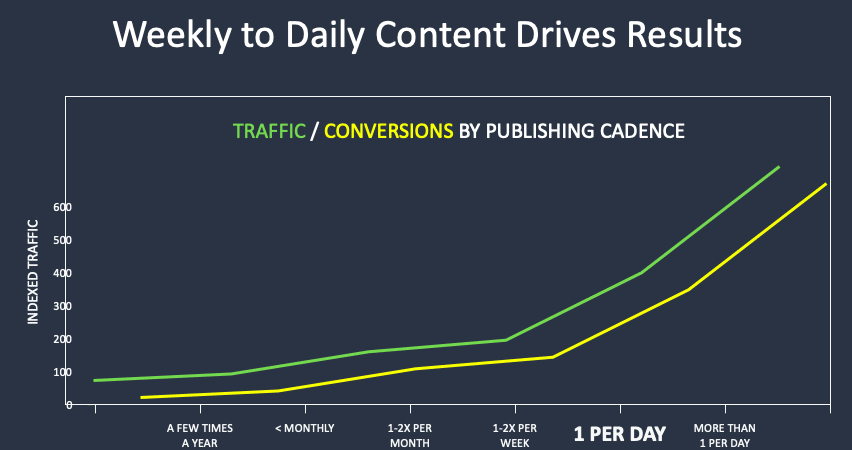
What Does All this Data Mean?
Consistent, regular publishing does seem to increase site traffic and leads. This doesn’t mean that quantity is always better than quality. While it is good to have a large library of posts, they still need to be well crafted and be meaningful to your audience.
So, what other data or research can corroborate these findings and add more insight? Let’s look at a 2018 Survey of 1,000+ bloggers from Orbit Media with analysis from expert Andy Crestodina, who is an esteemed colleague.
Why Are Some Blogs More Successful than Others?
That is the question that Andy tries to answer in his analysis of data. The survey consisted of asking bloggers specific questions grouped into three sections:
- Length, Time, and Frequency
- Process and Measurement
- Content Formats, Original Research, and Promotion
For the topic of frequency, we’ll look at the first section, which included these questions:
- How long is your average blog?
- Home much time do bloggers spend on an article?
- How often do you publish blogs?
The data points that are of real interest to frequency relay to question three. First, Andy notes that blogging frequency has been in a gradual decline over the last five years. In 2014, the most frequent answer was “several times per week.” Now, the answer changed to “several times a month.” The percentage of bloggers that publish every day has declined by half in this time period.
This decline could be because the survey also found that bloggers spend more time crafting a blog than they did in 2014. Thus, if a blogger spends more time per blog, it would make sense they would publish less.
Here is the full frequency of blogging results:
- More than daily: 2%
- Daily: 2%
- Two to six posts a week: 18%
- Weekly: 21%
- Several times a month: 23%
- Monthly: 15%
- Less than monthly: 5.7%
- Irregular intervals: 15%
However, nothing in the data associates fewer blogs with more benefits. The next analysis looks at the percentage of bloggers that reported “strong results” by publishing frequency.
Overall, bloggers who publish weekly were 2.5 times more likely to report “strong results” than bloggers publishing monthly or less.
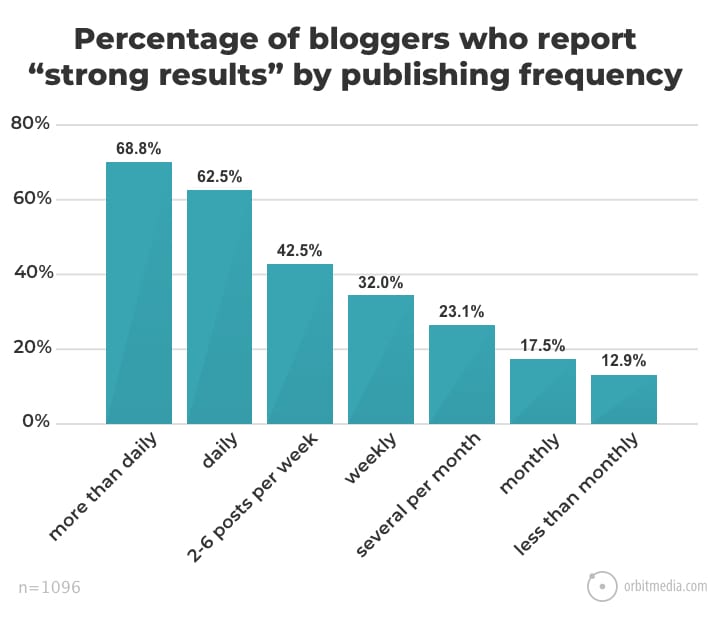
- More than daily: 68.8%
- Daily: 62.5%
- Two to six posts a week: 42.5%
- Weekly: 32%
- Several times a month: 23.1%
- Monthly: 17.5%
- Less than monthly: 12.9%
The data from this study does make some connection between frequency and benefits. “Strong results” could be interpreted many ways and isn’t as exact as the Hubspot research which successfully linked high volume and frequency to site traffic and leads.
Quality vs. Quantity
This has been an ongoing debate in the marketing community. The data just shared above certainly endorses that quantity is a big indicator of success. Some would argue that with high frequency, there is no way to keep up the quality. That’s a false assumption.
One of the most important things to do is to find a content ROI formula that works for your business as far as quantity is concerned. Then once you have identified what type of quantity you need to be at based on factors like your company size, B2B vs B2C, and industry, you have to put a plan in motion to scale content production.
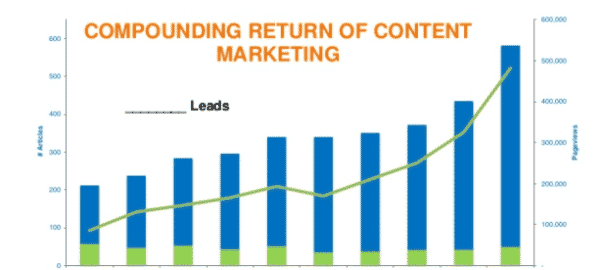
You may think that you don’t have enough ideas to increase the volume of blogs post created. Where will you find inspiration? There are specific tactics to take to expand your blog content ideas:
- Activate your experts by asking them what topics are most on trend or what’s new or forthcoming
- Tap into your sales team to find out what prospects and customers ask about most
- Look into existing research in your field
- See what your competitors are writing about
- Refresh old content
These are ways to ensure you have both quantity and quality because there’s plenty of blogs out there that have no value. They suffer from SEO stuffing, false narratives, and no supporting arguments.
Yet, we still keep hearing from experts to create less content; but even experts change their mind. In a post for Buzzsumo, Steve Rayson argues that the “future is more content.”
He makes this strong point based on some compelling data. The Washington Post publishes about 1,200 posts a day, which is way beyond what any non-publishing brand would be able to write. While Steve initially thought this type of quantity would dilute their traffic, this was an erroneous assumption. In fact, The Washington Post saw its web traffic grow by 28%.
This new approach to increasing content was actually put in place by the Post’s owner and Amazon chief, Jeff Bezos. This trend of more is universal. The number of Google indexed pages grew by more than 100 trillion in four years to 130 trillion in 2016. The number of indexed pages is no longer noted on the How Search Works Google page, but it’s certain that this number has increased significantly.
So why is more content the way to go? Steve offers some points that are hard to argue with that align with the Post’s strategy.
First, the Post and those with a similar strategy still care very much about quality. Steve notes in his post that science-related publications are also creating more content. There are over 28,000 scholarly peer-reviewed journals publishing over 2.5 million new scientific papers each year.
There is also the emerging trend of automated content, which includes algorithm-driven content. There are better tools available now for publishing and distributing content. Internet access and literacy rates continue to rise meaning more people can consume content. It’s also less costly to create content now than years ago. All these points are a huge catalyst for more content.
But is blogging frequency really indicative of success? Is it all just convenient data to make a point? Who has a contradictory view?
The Ideal Blogging Frequency Doesn’t Exist
That’s the statement from the experts at Moz, who certainly have a lot of expertise and experience in content. So, we should probably hear them out.
The folks at Moz think a lot of the data supporting higher frequency is misleading. They argue that correlation and causation should be totally separate. Basically, they say that frequency doesn’t matter as much as these things:
- Are the visits you are receiving because of more posts valuable? You could have a lot of traffic to your site, but those visitors may not be your ideal buyers and would never become a customer.
- The data that’s been presented that aligns quantity with traffic and leads, what industries and sectors are they? If they aren’t in your industry, then it’s hard to say that the quantity would have the same correlation. If you’re a manufacturing company, you probably don’t have much use for data from retail brands.
- Matching your goals and content schedule. If you are seeking to increase your viewership for a particular series, or drive traffic by writing about specific promos or events, then it makes sense to increase the frequency of blogs. However, if your goals are different and based on other elements like seasonality, then it may behoove you to publish less.
- Consistency matters more than frequency. If you want a consistent audience, then you must also be consistent in your publishing. People get in the habit of coming to your blog and expecting new content.
- Creating posts that attract more attention and are amplified is more beneficial than sheer frequency. If you have 11 posts that get an average number of views, that’s fine. But if you have less than 11 blogs, and several of those get lots of backlinks and shares on social media, then your traffic and leads will increase, not solely based on quantity.
So while I agree with these questions and concerns, they don’t present evidence against increasing blog post frequency. Just really good questions to ask about the data. In the end, we recommend you test it out for yourself. And listen to industry experts like The Media Captain:
How Often Should You Post?
Well, we’ve examined quite a bit of data and seen arguments from experts on both sides of the issue. So, simply put, how often should you post?
The very easy answer is, it depends! Quantity does have the ability to get your site hopping with visitors. However, you shouldn’t publish content just for the sake of saying you have more posts. You should align your frequency to your content goals, as well as consider what resources you have to create content. The size of your company, and whether it’s B2B or B2C, also matters.
Invest in Content for More Traffic and More Leads
What’s for sure is that you need to invest in content, and you can do that more effectively when you use a blog writing subscription service. A blog writing subscription service is one that delivers relevant content for your audience from professional writers. It’s high-quality content without any time investment from you. It’s on-demand content production.
There are lots of advantages to using such a service. You’ll save time and can be confident that the writers creating your content are qualified. All content will be optimized for SEO to increase your rankings in search. Plus, they come up with the content plan for you, which means it’s something you don’t even have to think about. Further, you can expect a quick turnaround and know that the work is 100% original and error-free.
Build awareness of your brand, attract new customers, and connect more deeply with your readers when you use a blog writing subscription service. Once you have blog content published consistently, you can then look at your own data to identify what the “perfect” frequency of blogging is from your specific company.
If you are ready to get more traffic to your site with quality content that’s consistently published, check out our Content Builder Service. Set up a quick consultation, and I’ll send you a free PDF version of my books. Get started today and generate more traffic and leads for your business.



![AI vs. Human Content: What Actually Gets You Results? [Research Report]](https://marketinginsidergroup.com/wp-content/uploads/2023/11/AI-vs.-Human-Content0.png)



Excellent article! I love the takeaways up front and then the details. Also, loved that you offered a different perspective to consider that the ideal blogging frequency doesn’t exist. I definitely believe that the more frequent the better, as long as quality and value are not sacrificed. For beginners (like I discuss in this blog https://diyonlinecontent.com/how-often-should-i-post-on-my-blog/), I recommend at least once a week and then working towards twice or 3 times per week. Thank you for this great insight!
Great post. I love it. But as for the frequency of blogging, I agree with the Moz experts.
Publishing content frequently doesn’t matter much. It’s not about drawing many leads or high traffic to your business but ones that will convert and become business.
The content production should aim at ranking at a search engine and drawing the right traffic that converts.
A study by Ahrefs experts shows that most of the content produced just ranks for a short time and then their traffic fade over time.
Your content should bring passive traffic to your business.
Thanks James. Google rewards those who publish consistently valuable content on a topic with authority on that topic. So the rankings and traffic are not short-lived. Our analysis of the data shows that weekly content on a particular topic that generates engagement (shares and inbound links) delivers long-lasting rankings and traffic.
The more often you post, the more activity you’ll get. Users have found a positive correlation between frequency and engagement. When posting frequency wanes, some have experienced drops in traffic up to 50%.
That’s really the heart of it. It’s like in a human conversation. You don’t just stop responding to others. The more you add to the conversation, the more response and feedback you get!